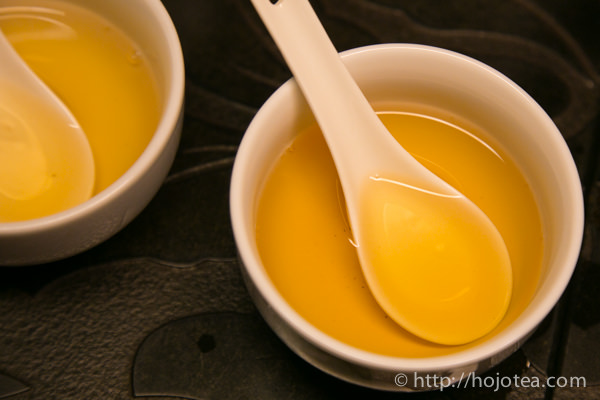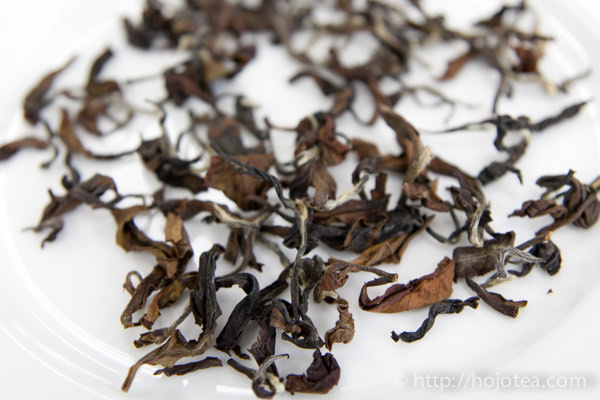- HOME >
- Tea Processing
The Green Fly that Produces the Muscatel Flavor of Oriental Beauty

Most people associate Taiwan oolong tea as a lightly fermented tea, which is often called as high mountain tea. Nevertheless, there is one distinctive oolong called Oriental Beauty, which has a completely different characteristic from other Taiwan oolong teas. The Oriental Beauty is a deeply fermented tea. If you take a look at its tea leaves, the colour is very similar to that of a black tea. Although its appearance is more like black tea, based on the sequences in tea processing the Oriental Beauty is still categorized as the oolong tea group.
Black Tea
Withering >> Rolling >> Fermentation >> Heating to stop fermentation
Oriental Beauty
Withering & Fermentation >> Heating to stop fermentation >> Rolling
Due to the sequence in the process, the Oriental Beauty is technically categorized as oolong tea.
The muscatel flavour that reminds you of Muscat wine
The main character of Oriental Beauty is its distinctive muscatel flavour. In Chinese, the flavour of Oriental Beauty is called as Mi Xiang which means honey flavour. In my opinion, the flavour of Oriental Beauty quite resembles to those late-harvested wines such as Ice Wine.
Do you know how this muscatel flavour is made?
The material being used for the Oriental Beauty itself is not the same as the rest of Taiwan high mountain oolong teas. No matter how much skill the tea master has, they cannot produce this muscatel flavour if they use ordinary tea leaves. Hence, if the farmer wishes to produce the Oriental Beauty, he has to collect a special type of tea leaves.
The Oriental Beauty is made of the tea leaves attacked by little green insects
To make this distinctive flavour of Oriental Beauty, the farmers have to collect the tea leaves that were attacked by tiny little green flies.

This insect is called the Empoasca onukiiMATSUDA and it is called 小緑葉蝉 in Chinese; sometime in Taiwan local tea farmers it is more commonly known as 小绿叶蝉. It is the tea green leafhopper, a common pest in tea garden. For most of other ordinary tea farmers, this insect is their pest; but, to produce Oriental Beauty, this insect is “precious” and essential. The tea garden must never be sprayed with any insecticide. Once the tea leaves are attacked by this insect, yellow spots will appear on the surface of the tea leaves; and, with further attack by this green insect, the tea leaves would turn as yellow as a banana skin. Thus, the growth of the tea leaves is suppressed with the intensive attack of this insect, which is why they are not welcomed in most of the ordinary tea gardens. Due to the attacks of the insects, these tea leaves will produce a substance called phytoalexin that is part of their self-defense mechanism (acts like an antibody for human). This substance (phytoalexin) is produced by plants when attacked by any pests such as insects or microorganisms. The phytoalexin of Oriental Beauty is called Terpenoid which is in a group called terpene; this substance generally gives a sweet fragrance. The terpene also exists in rose, citrus fruits and is a common substance found in various kinds of perfume. Furthermore, the main compound in insect repellents is also the various types of terpene. For example, it is said that mosquitos dislike the fragrance of lemon or lemon grass, which are also terpene. However for human, we generally are attracted to the fragrance of terpene. The terpene is produced when the self-defense mechanism of plants are triggered, protecting them against the attack of green insects. According to some researches, the substance being produced in responding to the insect attack is (3E,6S)‐2,6‐ Dimethylocta‐3,7‐diene‐2,6‐diol. This substance will be further oxidized and form hotrienol during fermentation and subsequent heating process. This would be the primary substance that contributes to the muscatel flavour of Oriental Beauty. If without the important role played by green flies, we wouldn’t be able to have had this distinctive muscatel flavour in tea.
Related Articles
How to get the latest update on HOJO Tea?
1. Follow Twitter, 2. Click "Like" on Facebook, and 3. Subscribe in newsletter. You can have the latest tea news from HOJO Tea.
 Subscribe the Newsletter to enjoy the privileges
Subscribe the Newsletter to enjoy the privileges- You may receive a free sample upon purchase, or you may have the priority to purchase special products. So please remember to subscribe our newsletter as well as the social network.
- New Release of High Mountain White Tea
- We are pleased to introduce our High Mountain White Tea, sourced from a unique tea garden with two key features: 1. Located at an altitude of 2200-2300m2. Completely wild and untended The ideal natural conditions of this garden result in tea of exceptional quality, offering a pure and gentle, nourishing taste. High Altitude and Wild …
- New Release of Da Xue Shan Wild White Tea 2024
- We have released the 2024 Da Xue Shan Wild White Tea Loose Leaf. This tea was produced under our direct supervision during our stay in Yunnan Province, ensuring meticulous production management on site. Definition of Wild Tea in Yunnan Province People in Yunnan strongly associate Camellia taliensis with wild tea, regardless of where it is …
NEW ARTICLES
 Why Do Some Teas Taste Astringent? Exploring the Causes and Mechanisms of Astringency
Why Do Some Teas Taste Astringent? Exploring the Causes and Mechanisms of Astringency- Tea can range from having no noticeable astringency to possessing a very strong one. What causes this astringency? This article explores the causes and mechanisms behind astringency in tea. Causes of Astringency Astringency arises from the binding of tea components to proteins in the oral cavity, creating a sensation of tightness or dryness. The tongue …
 The Impact of Heat Sources on Tea Flavor
The Impact of Heat Sources on Tea Flavor- It is widely recognized that the material of a kettle plays an important role in shaping the taste of water for brewing tea. Yet, an often overlooked but equally significant factor is the type of heat source used to boil the water. Different heat sources, whether gas, electric, charcoal, or wood fire, can impart distinct …
 New Release of High Mountain White Tea
New Release of High Mountain White Tea- We are pleased to introduce our High Mountain White Tea, sourced from a unique tea garden with two key features: 1. Located at an altitude of 2200-2300m2. Completely wild and untended The ideal natural conditions of this garden result in tea of exceptional quality, offering a pure and gentle, nourishing taste. High Altitude and Wild …
 New Release of Da Xue Shan Wild White Tea 2024
New Release of Da Xue Shan Wild White Tea 2024- We have released the 2024 Da Xue Shan Wild White Tea Loose Leaf. This tea was produced under our direct supervision during our stay in Yunnan Province, ensuring meticulous production management on site. Definition of Wild Tea in Yunnan Province People in Yunnan strongly associate Camellia taliensis with wild tea, regardless of where it is …
 New Release of Wild Pu-erh Jasmine Pearl
New Release of Wild Pu-erh Jasmine Pearl- Out of curiosity, we decided to create a jasmine tea based on Da Xue Shan Wild Raw Tea. This resulted in an exceptionally rare tea, not only in Japan but also in China. Custom Production Network for Jasmine Tea At our store, we source various types of base teas from different regions during the spring. …
 2024 Overview: Our Yunnan White Tea Quality, Process, and Weather Insights
2024 Overview: Our Yunnan White Tea Quality, Process, and Weather Insights- One of the teas we’ve been focusing on in Yunnan Province is white tea. Historically white tea has been produced in both Fujian Province and Yunnan Province for a long time. While white tea from Fujian Province is well-managed during processing, we are dissatisfied with the quality of the raw materials due to the use …
 Yunnan’s Hospitality Culture: Expressed Through Meals
Yunnan’s Hospitality Culture: Expressed Through Meals- In China, as a form of greeting, it’s common to say “你吃饭了吗?” which means “Have you eaten?” However, in Yunnan Province, the phrase “吃饭” is often used in various situations, more like “Eat, eat,” serving as an invitation to share a meal. Yet, with prolonged exposure to Yunnan, one comes to understand that these meal …
 In Search of Wild Tea: Exploring Mountain Villages in Southwest Lincang, Yunnan
In Search of Wild Tea: Exploring Mountain Villages in Southwest Lincang, Yunnan- We are currently sourcing tea in the southwestern part of Lincang City, Yunnan Province. One of the crucial products for us is wild tea. While tea processing is important, securing the raw materials poses the biggest challenge. Recently, we received information about a new location where wild tea supposedly grows. To verify this, we visited …
 New Release of Anxi Traditional Oolong
New Release of Anxi Traditional Oolong- Anxi, located in Fujian province, China, is celebrated for its Tie Guan Yin tea. However, the Traditional Anxi Oolong from this region boasts a unique fruity aroma, distinguishing it from Tie Guan Yin. Anxi: A Renowned Hub for Oolong Tea Production in China Fujian Province, renowned for its rich tea heritage, boasts several prominent tea-producing …
 Yunnan 2024 Spring Tea Sourcing
Yunnan 2024 Spring Tea Sourcing- Yunnan Province is globally renowned for the exceptional quality of its tea leaves. However, lax production management often presents challenges in achieving the desired tea quality when relying solely on pre-made teas. To address this issue, we have committed to remaining on-site throughout the spring season to closely monitor tea production. We are meticulously inspecting …
Shop Info

Address:Lot No. T-215, 3rd Floor, The Gardens Mall, Mid Valley City, Lingkaran Syed Putra, 59200 Kuala Lumpur
Tel: +603-2287-4537
Business Hour: 10am to 10pm
Category
- New Arrival at HOJO Online Shop
- Featured Articles
- Newsletter
- Types of Tea
- Origin of Tea
- Teapot and Tea Equipment
- Tea Column
- How to enjoy tea
- Tea Processing
- How to choose quality tea
- Tea constituents and functional effect
- Safety of Tea
- Foods
- Tea Business Operation
- Hobby and Outdoor Activity
- Ranking of Tea
- Video
- FAQ
- Media Release
Profile

- AKIRA HOJO
- I invite you to experience my tea selections.I was born in Nagano, Japan. In university, I studied agricultural chemistry, and I have the master degree in food science. I worked in Japanese food industry for 10 years. I involved in R&D, QC and QA. As a factory manager, I implemented ISO9000 series and managed the factory.
- The Art of Tea Magazine
- We posted the article on “The Art of Tea Magazine No.9, the magazine is published in Taiwan. We featured some scientific view about the tetsubin
- New Straits Times
- The Malaysian National Newspaper, New Straits Times featured HOJO Tea on 17-Oct-2007.
















